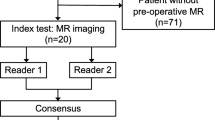Abstract.
The aim of this study was to compare the diagnostic performance of contrast-enhanced fast multiplanar gradient-echo (GRE) and T2-weighted fast spin-echo (FSE) image sets in the assessment of uterus, cervix, and vagina. Fast (up to 20 contiguous sections in 23 s) multiplanar GRE and FSE images of 45 patients referred for imaging of the female pelvis were evaluated retrospectively with regard to overall image quality and the ability to detect normal anatomic structures, as well as lesion conspicuity. Results were compared with histologic findings (n = 29) or clinical follow-up. Furthermore, a quantitative assessment of contrast-to-noise ratios among normal uterine and cervical structures as well as uterine lesions was performed for both sequences. On GRE images, uterine and cervical differentiation was best seen on the image sets acquired 15 and 60 s following contrast enhancement and results were significantly better compared with delayed images (p < 0.05). Delineation of the junctional zone was significantly (p < 0.05) better on FSE compared with GRE images; no significant difference was seen for the other anatomic structures. Overall image quality of GRE and FSE images was similar. Sensitivity for lesion detection based on both GRE and FSE images was 96 % with a sensitivity of 93 % for GRE, and 81 % for FSE images alone, respectively. Using the extended McNemar χ 2 test, the difference in diagnostic performance between FSE and GRE revealed no significant difference, whereas the combination of both techniques performed better than FSE imaging alone (p < 0.05). The presented data suggest that dynamic contrast-enhanced GRE imaging should be part of an MR examination of the female pelvis. Combined GRE and FSE imaging provide an excellent sensitivity in the assessment of uterine and vaginal pathologies.
Similar content being viewed by others
Author information
Authors and Affiliations
Additional information
Received 8 August 1997; Revision received 23 December 1997; Accepted 16 February 1998
Rights and permissions
About this article
Cite this article
Liu, PF., Krestin, G., Huch, R. et al. MRI of the uterus, uterine cervix, and vagina: diagnostic performance of dynamic contrast-enhanced fast multiplanar gradient-echo imaging in comparison with fast spin-echo T2-weighted pulse imaging. Eur Radiol 8, 1433–1440 (1998). https://doi.org/10.1007/s003300050569
Published:
Issue Date:
DOI: https://doi.org/10.1007/s003300050569




